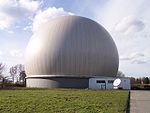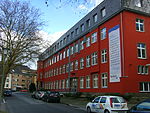Stiepel Priory
Buildings and structures in BochumChristian monastery stubsChristian organizations established in 1988Cistercian monasteries in GermanyMonasteries in North Rhine-Westphalia ... and 1 more
North Rhine-Westphalia building and structure stubs

Stiepel Priory is a Cistercian monastery in Stiepel in Bochum, North Rhine-Westphalia, Germany. It was founded in 1988 at the instigation of Franz Hengsbach, first Bishop of the Diocese of the Ruhr. It is a dependent house of Heiligenkreuz Abbey in Austria. The priory church is also a place of pilgrimage to the Blessed Virgin Mary, which is taken care of by the monks and the local parish.
Excerpt from the Wikipedia article Stiepel Priory (License: CC BY-SA 3.0, Authors, Images).Stiepel Priory
Am Varenholt, Bochum Stiepel
Geographical coordinates (GPS) Address External links Nearby Places Show on map
Geographical coordinates (GPS)
| Latitude | Longitude |
|---|---|
| N 51.431766666667 ° | E 7.228675 ° |
Address
Zisterzienserkloster Bochum-Stiepel
Am Varenholt 9
44797 Bochum, Stiepel
North Rhine-Westphalia, Germany
Open on Google Maps









